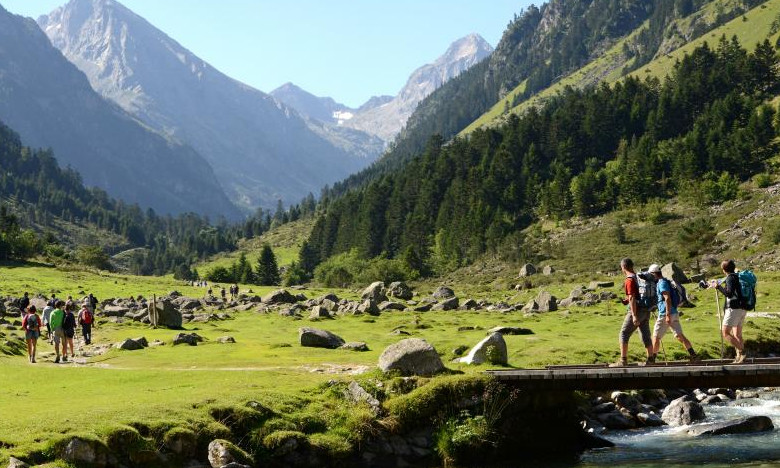MIDI-PYRENEES: A REGION MADE FOR HIKERS! In the Pyrenees, all along the Camino de Santiago (aka the Way of St. James) and in the lands around Toulouse, Conques or Rocamadour, there isn't a Midi-Pyrenees landscape without a trace of a walking trail. The latticework of paths is so dense that it's a dream come true for anyone with hiking boots at the ready. • The GR®10: The GR®10 traverses the Pyrenees Mountain chain from west to east, from the Atlantic to the Mediterranean. It's a legendary trail that every hiker dreams of tackling one day: more than 500 miles of pure happiness, one part of which – some would say the best part – is in Midi-Pyrenees. In fact, nearly 300 miles of the GR®10 are in our region, all along the central Pyrenees, as well as those in the Ariège. Here we have mountain passes at more than 6,500 feet of elevation, summits rising beyond 10,000 feet, stunning natural sites and breathtaking panoramas. They're all part of what's in store for anyone ready to explore these mountainscapes, the highest in the Pyrenees. • The Cathar Trail: Between Ariège and Catalonia, at the heart of the majestic central Pyrenees, you can relive the epic flight of the Cathars by walking the paths that these "Good Men" followed when they took refuge in Spain to escape the Inquisition. "Good men" or "good Christians" is what the believers in the Cathar movement called themselves. They put down strong roots in Midi-Pyrenees at all levels of medieval society. After the end of the crusade against them organized by the Pope in 1209, the Inquisition took up the cause in the region in an attempt to complete the eradication of these "evil spirits" who advocated values different from those of the Catholic Church. For a very long time – approximately 1230 to 1310 – risking exodus over prison or the stake, a great many Good men took refuge first in the mountains of Ariège and then across the border on Spain. Nobles, notables, merchants, tradesmen and farmers were all deemed heretics. What they left behind is what you will find along this superb hiking route. • The Tour of Larzac's Templar Hospitaller Sites: Just south of the Aveyron, near the Millau Viaduct, if you gaze across the vast and wild horizons of Larzac, now a World Heritage Site, you will discover a collection of city-estates built by the legendary Knights Templar and Hospitaller. Beginning in La Couvertoirade, you will immerse yourself in the fascinating history of the Templars and Hospitallers who shaped the Larzac plateau. You will follow grassy paths, small roads and old rutted trails lined with boxwoods or low walls. Such a tour of Larzac will lead you from one Templar or Hospitaller village to another, taking in the unexpected appearance of the ramparts of Sainte-Eulalie de Cernon, as well as those of La Cavalerie, Saint-Jean d'Alcas and Viala du Pas de Jaux. These city-estates and strongholds are part of the area's exceptional and remarkably well-preserved heritage. They were built in the 12th century by the Knights Templar, fortified in the 15th century and managed until the 18th century by the Knights Hospitaller, who took over from the Templars after the abolition of the Order.
Larzac's preserved, majestic and unblemished nature is the backdrop for your hike. It is both the centerpiece of "The Causses and the Cévennes," an area listed by UNESCO in 2011, and one of the jewels of the Grand Causses Regional Natural Park.
MIDI-PYRENEES: A CYCLETOURISM ELDORADO
Cyclists travel from far and wide to follow the route of the Tour de France in the Pyrenees. It is one of those must-dos that make Midi-Pyrenees a region where cycling is king. That said, cycletourism can be enjoyed throughout the Midi-Pyrenees region: coasting along the Canal des Deux Mers, crisscrossing the Lot Valley on the way from the Atlantic Ocean to the Mediterranean, tackling the Route du Tarn. Through pretty villages and historic sites, Midi-Pyrenees offers an amazing selection of bike itineraries where no two climbs or descents are the same and the vistas, a new one around every bend, are always spectacular.
Most cyclists who come to the High Pyrenees do so to ride the climbs made world famous by the Tour de France, which started in 1910: the Col du Tourmalet, Col du Soulor, Col de Peyresourde, Col d’Agnes and many more. All riders can have their efforts rewarded by getting a High Pyrenees Cycling Certificate. A respected way of proving your accomplishment, the certificate is obtained by presenting a Passeport Vélo (which never expires) listing 14 cols.
AFTER YOUR HARD WORK COMES COMFORT: WELLNESS AND RELAXATION IN MIDI-PYRENEES
Thermoludism is the word used to describe relaxation and pampering in thermal waters. In this realm, Midi-Pyrenees has the greatest concentration of thermoludic centers in France: 10 of them, all designed around collective thermal water pools and fountains.
Set against the splendid backdrop of the Pyrenees, they are some of the best thermoludic facilities in Europe. Aquersis, for example, takes you on a journey from Finland to the Far East. Sensoria plunges you into an Aragonese canyon setting. At Les Bains du Couloubret you are eased into the refined atmosphere of the baths of ancient Rome.
Jacuzzis, hydromassage, musical baths, tropical showers, waterfalls, hammams, sauna, bubble beds… Midi-Pyrenees has everything you need to freely and easily experience the pleasures of a thermal water of exceptional thousand-year-old properties pulled from the depths of the Pyrenees Mountains and lands rich in trace elements.


